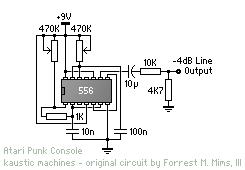One very obvious problem is that you have not removed the strips between the pins of the IC. Thus pin 1 is connected to pin 14, 2 to 13, 3, to 12, etc., etc.
There are also no other breaks in any of the strips, so you may have inadvertently connected other parts of your circuit.
In addition you're using way too much solder, and you should try to fold the leads over less (not at all is best, but if you need to keep them in place just splay the leads a little).
Check out
this site. I still think he's using too much solder, but it's a lot better. Notice how he cuts the tracks.
Here is a page that shows some bad soldering and some better soldering. Yours looks more like the former. Aim for the latter.
There are many tutorials on the net, but the basic technique is to have a little solder on the tip of the iron (enough that it looks nice and shiny, but not dripping off). Hold the tip against both the lead and the pad for a second or two, then apply a small amount of solder to the wire and the pad, near where the tip is touching them (or to the point where it is touching them). You only need a very little, enough that the pad and the wire gets a nice even coating and the hole is obscured. The final joint should look more like a ski slope coming down from the wire to the board than a boulder on the board with the wire growing out of it.





